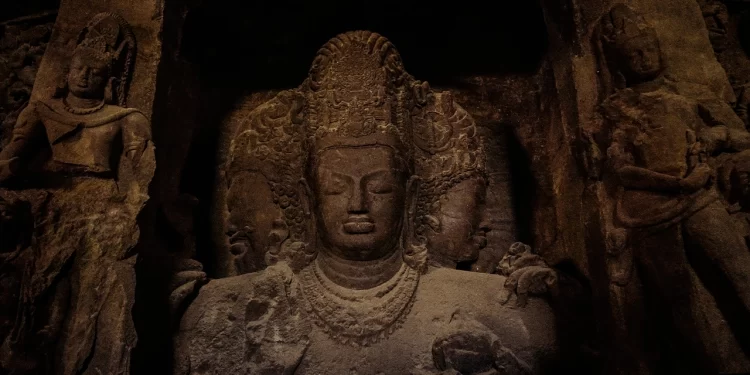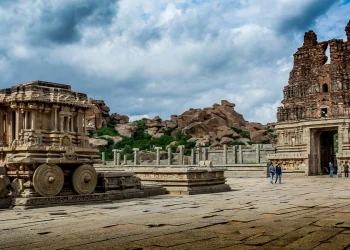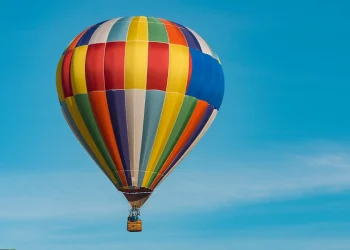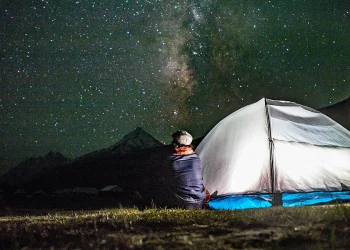It is a hot unforgiving day in Mumbai – I am in Andheri, a bustling hub in the west of the gigantic cosmopolis, but here in the basalt, rock-cut cocoon of the Mahakali caves, time seems to have been trapped in a bubble. The skies are silent, blue, and only interrupted by the flight of a coppersmith barbet. The red gulmohur trees sway gently, and the rocks feel surprisingly cold inside the caves – in the darkened silence all around, they seem to be meditating exactly as their inmate monks would have, about 2000 years back.
Also Read: A Comprehensive Guide To Agra’s Treasures
On first glance, these 19 Buddhist caves seem uninteresting, belittled by the high-rises of the 21st century all around – there seems nothing spectacular, but closer inspection will reveal minimalist viharas (cells where Buddhist monks used to meditate, and incidentally the term that gave the state of Bihar its name), a slightly larger chaitya (prayer hall where the monks would congregate) containing a pockmarked stupa (hemispherical structure that would in larger ancient monasteries contain relics) – the triumvirate that completes any Buddhist monastery.
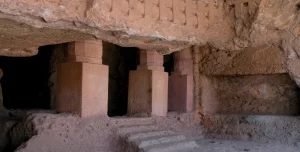
Further scrutiny will reveal dilapidated rock- cut sculptures standing as silent sentinels over two millennia since the times of Ashoka, cisterns for rain-water harvesting and inscriptions in Pali, a language older than Sanskrit.
It was in this time bubble of the Mahakali or Kondivite caves (apparently named after a Kali temple nearby with the stupa often mistaken for a shiva-linga) that I first realised that, besides the pinnacle in Ajanta and Ellora, there were scores of rock-cut caves strewn all over the Deccan, many to be found right here within the city.
Also Read: Lake Komani And Beyond: A Voyage To Albanian Bliss
The Mahakali caves were, in a way, a revelation or a prologue to my quest to further understand more of these rock-cut shards of history that lie unobtrusively in Mumbai and beyond.
Elephanta Caves
Perhaps the grandest of all the Hindu caves around Bombay is the Elephanta Caves (others being Jogeshwari and Mandapeshwar, though much smaller in scale). It was possibly a Buddhist site first evident from a few Buddhist caves, but it is largely famous today for its Shaivite sculptures, perhaps developed after the 5th Century AD by the Kalachuri dynasty. The statues showcasing various stories from the Shiva Purana are grand both in size and exquisiteness.
The Elephanta Caves is one of three UNESCO World Heritage Sites in Mumbai (the gargoyle laden CST station and the art deco buildings in the Fort area being the others, while Ajanta and Ellora complete the UNESCO list for the state of Maharashtra).
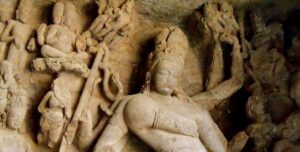
Once called Gharapuri (the village of caves), travellers to Elephanta will definitely find the ferry journey from the Gateway of India delightful. As I felt the salty breeze of the Arabian on the journey, it felt quite mystical to sail this far to see medieval Hindu caves, but I reminded myself again that this was once, archipelago land.
The name, Elephanta, came from the statue of an elephant that once used to stand on this island, and was used as the most important landmark for disembarking boats – today, the reconstructed and renovated elephant statue can still be seen at the Jijamata Udyan.
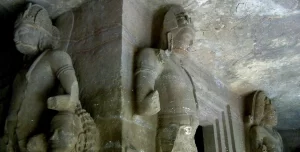
The grandest sculptures in Elephanta can be seen in what is called the Great Cave – complete with 4 entrances, guarded by gigantic dwarpalas or gatekeepers, and full of larger-than-life sculptures of Shiva in his various forms. There is almost a sense of poetic fluidity in these sculptures – dynamic, full of gestures and almost arising from the rocky walls on which they were carved.
Of these, the magnum opus is the three-headed Trimurti or the Sadashiva (the eternal Shiva), a depiction of Shiva with three heads and symbolising the trinity of creation – preservation – destruction all within himself.
Also Read: Oldest Surviving Places In The World
There are many other depictions of Shiva in this cave of grandeur – there is the exuberant mutli-armed depiction of Nataraja, the divine dancer; then there is the graceful Ardhanarishwar – the androgynous version of Shiva that conjoins male and female. Mahadeva is also depicted as the Gangadhar Shiva, where he receives Ganga from the heavens on Earth to cleanse and redeem the sons of Bhagiratha.
There are very few places in the subcontinent where the stories of Shiva are brought to life in this grandeur in a rock-cut montage. A day spent in Elephanta will surely rekindle your interest in the Puranic stories, if not in the wider realm of Indian rock-cut architecture where this small island undoubtedly joins the likes of Ellora and Mahabaleshwar.
The Kanheri Caves
The Kanheri Caves were maybe Buddhism’s reply to Elephanta and are today located near Borivali in the western part of Mumbai within the Sanjay Gandhi National Park – one of the largest urban national parks (housed within a city) in the world.
Today, the urban sprawl that is Mumbai has swallowed the forests around the National Park, but centuries back, the pilgrimage to these caves at the top of the Krishnagiri (or Kanhagiri, thereby Kanheri) would have been as big an adventure as sailing over to Elephanta.
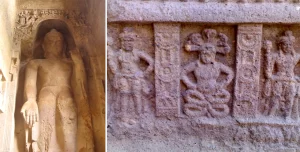
On the crest of a volcanic hill, crossing dense forests, criss-crossing rivers and waterfalls is part of the excitement in reaching this time-bubble that has thankfully been preserved quite well. Lasting over a millennium from the 1st century to the 10th century AD, the precinct has over 100 caves, the scale a representation of the importance of Kanheri as a Buddhist centre in medieval India – apparently also visited by Chinese traveller Hieun Tsang in his Buddhist pilgrimage across India.
Developed over three hills, Kanheri is enormous – and if you go with the curiosity of an explorer, every inch of the carved caves will fill you with excitement and amazement.
Also Read: Konark Sun Temple: An Architectural Marvel And Spiritual Haven
While Kanheri is large and austere, it also has sections with incredible sculptures – rock cut figures of donors, exquisitely carved pillars with rich capitals, a cavernous chaitya hall, stupas and entire walls decorated with depictions of the Buddha and the bodhisattvas and Nagas – in fact, giant statues of the standing Buddha greet you towards the very beginning at Cave 3 and may remind you of Bamiyan with its similar standing Buddhas, carved out of a rocky mountain face.
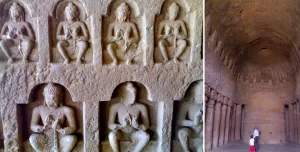
If you visit Kanheri, do take some time to sit down and look at the sprawling city as well. Parts of the Mumbai skyline make a valiant effort to bring you back to the present while the Global Vipassana Pagoda at Gorai glint gracefully in gold (based on Myanmar’s Shwedagon pagoda) and remind you that the message of the Buddha is still alive, relevant and offering a source of strength even today after centuries.
There are other Buddhist caves in Mumbai, much smaller in scale – such as the Magathane and Jogeshwari caves, though some of these have heavily dilapidated over time. Nonetheless, if you are still thirsty to purse Buddhism and its cave temples, you will need to head out of Mumbai, towards Pune, following the ancient trade routes where more surprise, subtlety and sublimity await in the Sahyadris.
The Karla Caves
Just 10 km away from the tourist hotspot of Lonavala, 90 km south east of Mumbai lies yet another spectacle – the Karla or Karli Caves. The Mumbai-Pune expressway zips nearby, but time will tell you that this modern-day superfast highway has only built on layers of the past – this was indeed an important trade route in the Deccan leading to frequent travels by traders and merchants – and prompting the development of Buddhist monastic caves that not only supported and sheltered these traders but also benefited from their benevolence. This is what led to the rise of the Bhaja caves, the Bedse caves and the grandest of them all, the Karla caves, dating from the 2nd Century BC to the 5th century AD.
Though there are only 16 caves here, it is the grand Chaitya hall of Karla that earns it, its laurels
At a height of 14m, and running 45m long, it is the largest chaitya hall in India, complete with a series of 15 octagonal pillars on each side, topped with exquisitely designed capitals and filled with sculptures of men, women and animals.
Also Read: When You’re In India, These Are The Spots You Simply Can’t Miss
It is said that the artistry of the chaitya hall was improved over centuries first at Bhaja and Ajanta, then at nearby Nasik Caves, Bedse caves to eventually be perfected at Karla. The chaitya hall at Kanheri was made later and is a replica of Karla.
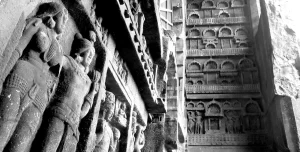
Not just large, Karla also retains the chaitya in its original form, replete with the wooden semi-circular beams supporting the roof (and making one feel as if he is inside the ribbed belly of a leviathan). Not just that, the wooden umbrella (indicative of enlightenment akin to halos on Christian saints) atop the rock hewn chaitya still remains intact from its original times.
Outside the Chaitya is a large facade carved with windows ensuring ample illumination of the structures within. There are large statues of elephants within the caves (reminiscent of Elephanta) and are also amply represented on the capitals of the pillars carrying men and women.
Also Read: An Exciting Guide To The Most Extreme Places Of Earth
There are inscriptions on the caves reminding of the donors, particularly the Satavahan kings, while mention of Yavan donors (Greeks or Greek speaking people) remind us how cosmopolitan was this place even two thousand years ago.
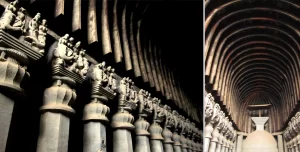
If you travel around the Sahyadri Ghats of Mumbai and Pune, you are sure to come across some of these fascinating caves that will take you back in time. Perhaps besides the popular names and finds, there are many more that have been obscured and are yet to be found.
New caves in the Kanheri complex were discovered as recently as 2016, while some were found in Nasik in 2021.
I still remember I was hiking in the hills of Igatpuri (100 km from Mumbai) when I stumbled upon an old cave dripping with the monsoons, clad in moss but still full of sculptures and pillars. I later found that these were Jain caves, with carvings of Rishaba, and though derelict, they were revered by the locals.
Also Read: 9 Most Beautiful Sea Bridges Around The World
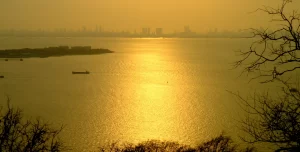
Perhaps the ease of carving volcanic basalt from the Deccan traps is what contributed to the proliferation of these cave temples. It is also possible that factors like the Indo-Roman trade or religious tolerance and the desire for religious merit played a role in the establishment of these cave temples.
Whatever be the cause, their existence in the 21st century is reason for celebration enough and we should make every effort not just to preserve them but also learn from them the tales of history. So the next time you find yourself surrounded by these cave temples, either inside or outside the bustling city of Mumbai on a hot sunny day, take your time to look beyond their rocky exterior and allow the caves to whisper to you. They have been whispering for centuries, reminding us that time flies, but eternity is written on these very rocks…
Ayan Adak is a business consultant by profession and loves travelling, writing and photography in his spare time.



